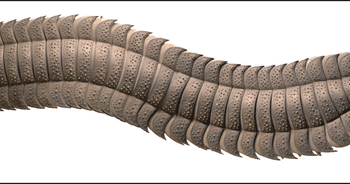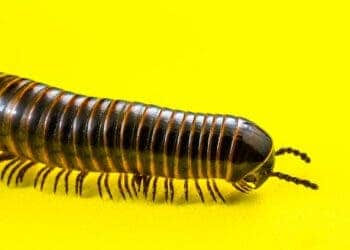
Around 300 million years ago, long before dinosaurs ruled the Earth, the Carboniferous period teemed with strange and giant life forms. Towering plants filled swampy forests, amphibians slithered across soggy ground — and massive arthropods like Arthropleura roamed the land.
This colossal, millipede-like creature stretched over two meters in length, making it the largest land-dwelling invertebrate ever discovered.
The world’s biggest bug gets a head
Arthopleura is the largest land-dwelling invertebrate ever discovered, and it was absolutely terrifying. It would have looked like something straight out of a horror movie, with its 40 pairs of legs and leg-like mandibles. Picture a millipede but it’s about the size of a car, weighs over 100 pounds (45 kilograms) and roams the forest and you’re probably pretty close to Arthopleura.
We know this creature was pretty widespread because paleontologists have found plenty of fossils of it, as well as the fossilized traces that it left on the soil. However, we had never found an intact head. So, most of what we know about Arthopleura was pieced together from incomplete specimens.
The new study focused on juvenile Arthropleura specimens preserved in iron-rich nodules from Montceau-les-Mines, an exceptional fossil site that has provided detailed insights into many ancient creatures. Using advanced imaging techniques, the research team reconstructed the head and mouthparts of Arthropleura, offering the most complete look yet at this ancient giant’s anatomy — and its face.
Looking straight into its face

The paleontologists, led by Mickaël Lhéritier of the Universite Claude Bernard, scanned the remains of several particularly well-preserved juveniles. They then used tomographic imaging techniques to recreate the faces of these creatures.
Their analysis revealed that Arthropleura had a hard, shield-like plate called a collum covering its head, along with stalked eyes, segmented antennae, and mandibles suited for chewing. These features suggest a diet of plants and detritus, though some researchers think it may have scavenged from time to time.
James Lamsdell, an associate professor of paleobiology at West Virginia University, wrote an accompanying article saying that there’s still a lot we don’t know about Arthopleura. It’s not just what it ate, we don’t even know exactly where it lived. The forest floor sounds like the most plausible option, but it could have also spent some time in the water, like an alligator.
“Without direct evidence from digestive tracts, it is still unclear exactly what Arthropleura ate,” he wrote. “The respiratory organs also remain unknown, leaving the possibility that Arthropleura was aquatic.”
The combination of a heavily armored body and many legs would have made Arthropleura well-suited to navigating through thick vegetation, possibly burrowing through leaf litter in search of food. Its slow movement likely made it a poor predator, reinforcing the idea that it was a herbivore or detritivore. Without better fossils, however, it’s hard to say for sure.

A gentle giant?
Determining Arthropleura’s precise evolutionary relationships is also a long-standing challenge for researchers. The general idea is that it was a myriapod (a group that includes millipedes, centipedes, and their relatives). But where exactly it fits on the evolutionary tree is less clear. The new study used total-evidence phylogenetics, a method that combines both morphological (physical) and molecular data to resolve evolutionary relationships.
Like millipedes, Arthopleura had seven-segmented antennae and a modified collum. However, like centipedes, it had fully encapsulated mandibles and leg-like jaw structures called maxillae. This research concludes that Arthopleura is a “stem group millipede” — meaning it shares common ancestors with modern millipedes but it is not technically a millipede itself. It may belong to an ancient group related to the millipedes or a transitional group between millipedes and centipedes.
But this begs the question: why did it grow so large?
Modern arthropods, like insects and millipedes, are much smaller. Naturally, this leads scientists to wonder what environmental factors allowed their ancient relatives to grow so large. One theory is that high levels of oxygen in the Carboniferous atmosphere, caused by the extensive forests, allowed for larger body sizes in arthropods, which rely on diffusion through their exoskeletons to breathe.
Additionally, the absence of large terrestrial vertebrates during the Carboniferous may have allowed arthropods like Arthropleura to dominate the landscape without competition from other large herbivores. However, as vertebrates evolved and diversified, including the appearance of early reptiles, these giant arthropods eventually faced new challenges that likely contributed to their extinction by the end of the Permian period, some 50 million years after they first emerged.
The study “Head anatomy and phylogenomics show the Carboniferous giant Arthropleura belonged to a millipede-centipede group” was published in Science Advances.






